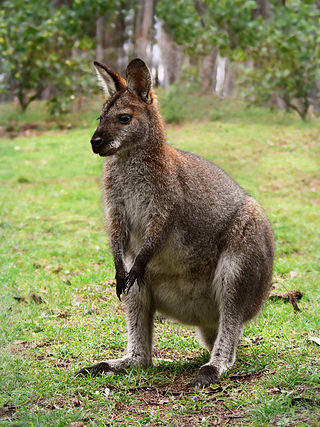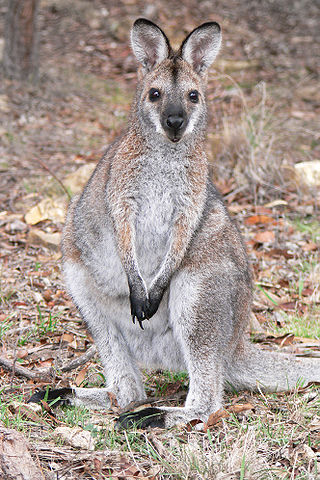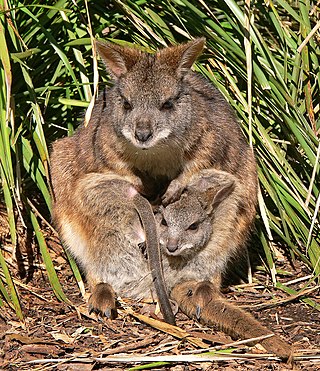
Kangaroos are marsupials from the family Macropodidae. In common use the term is used to describe the largest species from this family, the red kangaroo, as well as the antilopine kangaroo, eastern grey kangaroo, and western grey kangaroo. Kangaroos are indigenous to Australia and New Guinea. The Australian government estimates that 42.8 million kangaroos lived within the commercial harvest areas of Australia in 2019, down from 53.2 million in 2013.

A wallaby is a small or middle-sized macropod native to Australia and New Guinea, with introduced populations in New Zealand, Hawaii, the United Kingdom and other countries. They belong to the same taxonomic family as kangaroos and sometimes the same genus, but kangaroos are specifically categorised into the four largest species of the family. The term "wallaby" is an informal designation generally used for any macropod that is smaller than a kangaroo or a wallaroo that has not been designated otherwise.

Tree-kangaroos are marsupials of the genus Dendrolagus, adapted for arboreal locomotion. They inhabit the tropical rainforests of New Guinea and far northeastern Queensland, along with some of the islands in the region. All tree-kangaroos are considered threatened due to hunting and habitat destruction. They are the only true arboreal macropods.

Macropodidae is a family of marsupials that includes kangaroos, wallabies, tree-kangaroos, wallaroos, pademelons, quokkas, and several other groups. These genera are allied to the suborder Macropodiformes, containing other macropods, and are native to the Australian continent, New Guinea and nearby islands.

The parma wallaby is a small marsupial macropod mammal native to forests and densely-vegetated areas of northeastern New South Wales, Australia, close to the border with Queensland. There is also an introduced population found in and around Rodney District, just north of Auckland, New Zealand. About the size of a stout cat, it lives mainly under thick plant cover, and is only active at night when it emerges to feed on grasses and small plants. It is the smallest of the wallabies and carries its young in a pouch, as with other marsupials. Shy and elusive, it was believed extinct until its rediscovery in the 1960s.

The red-necked wallaby or Bennett's wallaby is a medium-sized macropod marsupial (wallaby), common in the more temperate and fertile parts of eastern Australia, including Tasmania. Red-necked wallabies have been introduced to several other countries, including New Zealand, the United Kingdom, Ireland, the Isle of Man, France and Germany.

The tammar wallaby, also known as the dama wallaby or darma wallaby, is a small macropod native to South and Western Australia. Though its geographical range has been severely reduced since European colonisation, the tammar wallaby remains common within its reduced range and is listed as "Least Concern" by the International Union for Conservation of Nature (IUCN). It has been introduced to New Zealand and reintroduced to some areas of Australia where it had been previously extirpated. Skull variations differentiate between tammar wallabies from Western Australia, Kangaroo Island, and mainland South Australia, making them distinct population groups.

Pademelons are small marsupials in the genus Thylogale, found in Australia and New Guinea. They are some of the smallest members of the macropod family, which includes the similar-looking but larger kangaroos and wallabies. Pademelons are distinguished by their small size and their short, thick, and sparsely-haired tails. Like most other marsupials, they carry their young in a pouch.

The swamp wallaby is a small macropod marsupial of eastern Australia. This wallaby is also commonly known as the black wallaby, with other names including black-tailed wallaby, fern wallaby, black pademelon, stinker, and black stinker on account of its characteristic swampy odour.

The Tasmanian pademelon, also known as the rufous-bellied pademelon or red-bellied pademelon, is the sole species of pademelon found in Tasmania, and was formerly found throughout southeastern Australia. This pademelon has developed heavier and bushier fur than its northern relatives, which inhabit northern Australia and Papua New Guinea.

The whiptail wallaby, also known as the pretty-faced wallaby, is a species of wallaby found in eastern Australia. It is locally common from Cooktown in Queensland to near Grafton in New South Wales.

The western brush wallaby, also known as the black-gloved wallaby, is a species of wallaby found in the southwestern coastal region of Western Australia. The wallaby's main threat is predation by the introduced red fox. The IUCN lists the western brush wallaby as Least Concern, as it remains fairly widespread and the population is believed to be stable or increasing, as a result of red fox control programs.

The red-legged pademelon is a species of small macropod found on the northeastern coast of Australia and in New Guinea. In Australia it has a scattered distribution from the tip of Cape York Peninsula in Queensland to around Tamworth in New South Wales. In New Guinea it is found in south central lowlands.

The ursine tree-kangaroo is a long-tailed, furry, bear-like mammal found only in tropical forests on the island of New Guinea. Slightly larger than a cat, it lives alone in trees and is active at night to feed on leaves and fruit. It belongs to the macropod family (Macropodidae) with kangaroos, and carries its young in a pouch like other marsupials. It has a small range in northwestern New Guinea and is threatened by habitat loss and hunting. Other common names for this species include the black tree-kangaroo, the Vogelkop tree-kangaroo and the white-throated tree-kangaroo.

Brown's pademelon is a species of marsupial in the family Macropodidae. It is found in New Guinea. Its natural habitats are subtropical or tropical dry forests, dry savanna, subtropical or tropical dry shrubland, and subtropical or tropical dry lowland grassland. It is threatened by habitat loss.

The dusky pademelon or dusky wallaby is a species of marsupial in the family Macropodidae. It is found in the Aru and Kai islands and the Trans-Fly savanna and grasslands ecoregion of New Guinea. Its natural habitats are subtropical or tropical dry forests, dry savanna, subtropical or tropical dry shrubland, and subtropical or tropical dry lowland grassland. It is threatened by habitat loss.

Calaby's pademelon, also known as the alpine wallaby, is a species of marsupial in the family Macropodidae. It is endemic to Papua New Guinea. It is threatened by habitat loss and hunting.




















